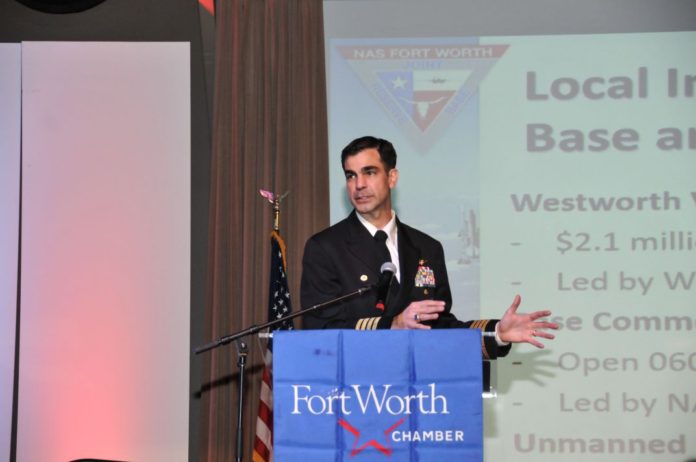Naval Air Station Fort Worth Joint Reserve Base
1510 Chennault Ave.
Fort Worth 76113
Construction is set to start in late February on a new main gate entrance at the Naval Air Station Fort Worth Joint Reserve Base.
The old main gate will be demolished and replaced with a new, more secure entrance gate that is also expected to improve traffic flow in and out of the base. The $2.8 million project is expected to be completed in October or November.
The main gate project is one of several redevelopment initiatives NAS Fort Worth JRB will undertake in 2016 to boost security and improve efficiency both on the base and around the communities where it is located. The installation covers 2,300 acres on Fort Worth’s west side.
“We’re always looking for ways to make things around the base much easier for everyone who works and lives around here,” said Capt. Michael Steffen, base commanding officer.
Steffen provided updates on development projects at the base during a Jan. 19 luncheon hosted by the Fort Worth Chamber of Commerce.
“These projects will help the base and the community,” he said.
Established in 1994 as the first joint reserve base in the country, the installation was first known as Tarrant Field in 1932 and was known as Carswell Air Force Base from 1948 to 1993. As a joint reserve defense facility, it is home to a variety of Navy, Marine Corps, Air Force, Army and Texas Air National Guard units. The base employs more than 10,000 active duty military, national guardsmen, reservists, federal civilians and contractors whose mission is to provide support and training for the country’s defense.
NAS Fort Worth JRB also serves 170,000 retirees in the Dallas-Fort Worth area.
“We’ve got a wonderful robust facility,” Steffen said. “The economic impact of the base is $2.5 billion. When combined with Lockheed Martin Aeronautics and Federal Medical Center Carswell, which are located next to us, it’s $9.2 billion.”
Last September, the base reopened a newly designed commercial vehicle inspection gate. That $6 million project relieves traffic problems by diverting large commercial trucks from the main entrance to the new gate off State Highway 183.
“It’s been a huge success,” said Steffen. “It makes it more efficient for everyone by relieving the congestion at the front gate for a more efficient process. Trucks can come right off the interstate and go through the gate. That was a big move for the local community.”
Steffen said construction on the new gate will bring it into compliance with current Navy Force Protection regulations as well as improving traffic flow.
“It will cause some traffic backups but we’ll do everything we can to prevent that. We’ll do all we can to keep traffic backups to a minimum,” he said.
The base also is working with the cities of River Oaks and Fort Worth to redesign and reconstruct Meandering Road. Funding for the engineering design on the $1 million project is from the North Central Texas Council of Government’s Transportation Improvement Funds (TIP) program. The redesign calls for widening and repaving Meandering Road and installing a traffic circle to help ease congestion. The project is in the design review process and work is expected in two to three years.
“The reason this project is such a good thing is it will not only facilitate smooth flow of traffic to the base but it will actually improve the through-put of traffic in that neighborhood,” Steffen said.
Additionally, the base is working with the Tarrant Regional Water District on a project that would tie its Airfield Falls Trailhead into the Trinity Trails system, a network of 40 miles of public trails and trailheads along the Trinity River.
Steffen said real estate developers, business owners and the public can partner with the base through NCTCOG’s Regional Coordination Committee. The committee has a review Web tool that provides a clearinghouse to share and discuss development projects that affect the surrounding communities.
“We like to have discussions with business members and real estate developers so that we can help show them where our noise footprints and our potential hazard zones are,” Steffen said. “The base is obviously very interested in partnering with local communities to ensure we have compatible development around the base.”






